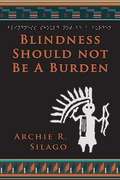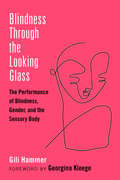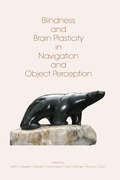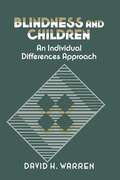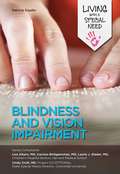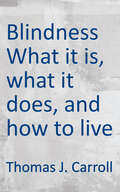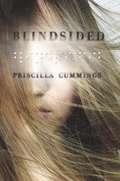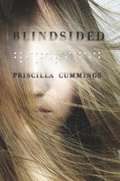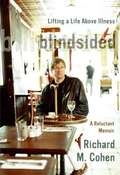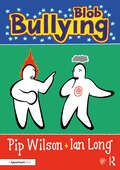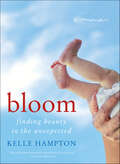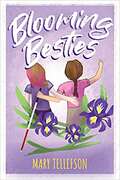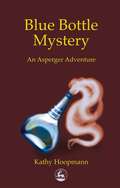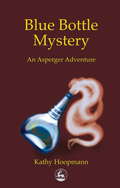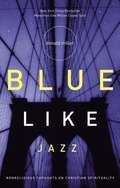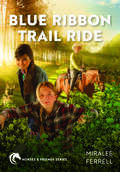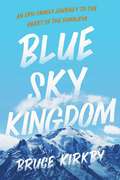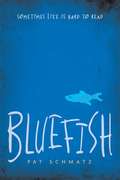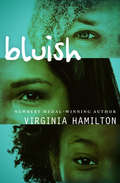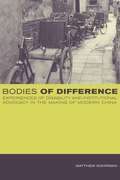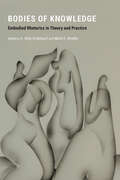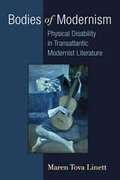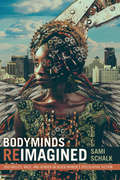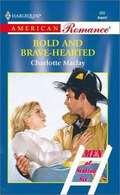- Table View
- List View
Blindness Should Not Be a Burden
by Archie R. Silago<P>Archie Silago is a member of the Navajo Nation. Archie was born in 1951 at Crownpoint, New Mexico. At 17, a detached retina left him blind in his right eye; five years later he suffered the same fate in his left eye and became completely blind. <P>Eventually, he decided to attend college. He received his Bachelor s Degree in Psychology from New Mexico State University, completed a Master s Degree in Counseling at Western New Mexico University and became a Licensed Mental Health Counselor (LMHC). Today he is pursuing his PhD in Psychology. This memoir is intended to inspire and motivate other individuals with disabilities to help themselves to move forward with life.
Blindness Through the Looking Glass: The Performance of Blindness, Gender, and the Sensory Body (Corporealities: Discourses Of Disability)
by Gili HammerModern Western culture is saturated with images, imprinting visual standards of concepts such as beauty and femininity onto our collective consciousness. Blindness Through the Looking Glass examines how gender and femininity are performed and experienced in everyday life by women who do not rely on sight as their dominant mode of perception, identifying the multiple senses involved in the formation of gender identity within social interactions. Challenging visuality as the dominant mode to understand gender, social performance, and visual culture, the book offers an ethnographic investigation of blindness (and sight) as a human condition, putting both blindness and vision “on display” by discussing people’s auditory, tactile, and olfactory experiences as well as vision and sight, and by exploring ways that individuals perform blindness and “sightedness” in their everyday lives. Based on in-depth interviews with 40 blind women in Israel and anthropological fieldwork, the book investigates the social construction and daily experience of blindness in a range of domains. Uniquely, the book brings together blind symbolism with the everyday experiences of blind and sighted individuals, joining in mutual conversation the fields of disability studies, visual culture, anthropology of the senses, and gender studies.
Blindness and Brain Plasticity in Navigation and Object Perception
by John J. Rieser Daniel H. Ashmead Ford F. Ebner Anne L. CornResearch into the development of sensory structures in the brains of blind or visually-impaired individuals has opened a window into important ways in which the mind works. In these individuals, the part of the brain that is usually devoted to processing visual information is given over to increased processing of the touch and hearing sense. This d
Blindness and Children: An Individual Differences Approach
by David H. WarrenIn this book, Dr. Warren summarizes and interprets the research literature on infants and children with visual impairments. He concludes that many aspects of delayed development are not the result of visual impairment itself, but rather of environmental variables that tend to accompany visual impairment. Thus, many of the typical developmental prdelays may be ameliorated or avoided by the appropriate structuring of the child's experiences. The author makes the argument that the goal of research in this area should be to understand the causes of variation within the population of visually impaired children, rather than making direct, developmental comparison with sighted children. Thus, the existing research literature is searched for evidence of variables that may account for individual differences, including particularly variables related to the child's multiple environments.
Blindness and Vision Impairment
by Patricia SouderIt's impossible to predict all the ways that being blind will affect a person's life. From relearning things like reading and moving around, to the emotional impact of not being able to see, blindness and vision impairments present people with a whole new set of difficult challenges. In this book, as you read the story of Kyla's vision impairment, you'll learn about many of the disorders and injuries that can cause blindness and impaired vision. You'll also find out about the techniques and services used to treat and deal with blindness, including guide animals, white canes, Braille, and programs such as special summer camps. Becoming blind doesn't have to get in the way of leading a fulfilling life!
Blindness: What it is, What it Does, and How to Live with it
by Thomas J. CarrollBlindness: What it is, What it Does, and How to Live with it
Blindsided
by Priscilla CummingsIn many ways, Natalie O'Reilly is a typical fourteen year old girl. But a routine visit to the eye doctor produces devastating news: Natalie will lose her sight within a few short months. Suddenly her world is turned upside down. Natalie is sent to a school for the blind to learn skills such as Braille and how to use a cane. Outwardly, she does as she's told; inwardly, she hopes for a miracle that will free her from a dreaded life of blindness. But the miracle does not come, and Natalie ultimately must confront every blind person's dilemma. Will she go home to live scared? Or will she embrace the skills she needs to make it in a world without sight?
Blindsided
by Priscilla Cummings<P>In many ways, Natalie O'Reilly is a typical fourteen year- old girl. But a routine visit to the eye doctor produces devastating news: Natalie will lose her sight within a few short months. Suddenly her world is turned upside down. <P>Natalie is sent to a school for the blind to learn skills such as Braille and how to use a cane. Outwardly, she does as she's told; inwardly, she hopes for a miracle that will free her from a dreaded life of blindness. <P>But the miracle does not come, and Natalie ultimately must confront every blind person's dilemma. Will she go home to live scared? Or will she embrace the skills she needs to make it in a world without sight? .
Blindsided: a Reluctant Memoir
by Richard M. CohenBook Description: Illness came calling when Richard M. Cohen was twenty-five years old. A young television news producer with expectations of a limitless future, his foreboding that his health was not quite right turned into the harsh reality that something was very wrong when diagnosed with multiple sclerosis. For thirty years Cohen has done battle with MS only to be ambushed by two bouts of colon cancer at the end of the millennium. And yet, he has written a hopeful book about celebrating life and coping with chronic illness.
Blob Bullying (Blobs)
by Pip Wilson Ian LongThis practical and accessible resource contains a wealth of discussion sheets and games to help victims of bullying reflect and talk about their experiences and feelings using the internationally familiar Blob figures. Diverse and inclusive, the Blob figures are a proven way to help children and adults share their feelings and experiences. Without age, culture or gender, they enable the individual to focus on feelings and body language. In this book, the Blobs explore bullying. From Blob Trees to Bingo games, cards and emotional scales, the Blobs provide a visual structure that allows children, teenagers and adults to open up about being bullied. Offering unique activities that help scaffold conversations for people of all ages and abilities, this is an essential resource for teachers, teaching assistants, youth and social workers, psychologists, counsellors and all those who work with and have caring responsibilities for others.
Bloodletting: A Memoir of Secrets, Self-harm, and Survival
by Victoria LeathamOn the Outside, Victoria Leatham appears to have it all. She's creative, beautiful, confident. But inside she struggles with silent, secret, and unbearable pain. In her late teens, Leatham is struck with an undeniable urge to cut herself. Oddly, the wounds she inflicts on herself mute the pain she feels inside. This memoir, a darkly humorous and often chilling account, vividly details Leatham's ordeal and reveals her most intimate thoughts as she struggles with cutting and a range of other psychological problems including eating disorders, sexual promiscuity, substance abuse, and bipolar disorder. And finally, it describes her discovery of the psychological secret that helps her escape from this spiral of self-destruction.
Bloom: Finding Beauty in the Unexpected—A Memoir
by Kelle Hampton“In her tender and genuinely beautiful memoir, Kelle Hampton encourages us to not simply accept the unexpected circumstances of our lives, but to embrace them like the things we wished for all along.” —Matthew Logelin, New York Times bestselling author of Two Kisses for MaddyBloom is an inspiring and heartfelt memoir that celebrates the beauty found in the unexpected, the strength of a mother’s love, and, ultimately, the amazing power of perspective. From the outside looking in, Kelle Hampton had the perfect life: a beautiful two-year-old daughter, a loving husband, a thriving photography career, and great friends. When she learned she was pregnant with her second child, she and her husband, Brett, were ecstatic. Her pregnancy went smoothly and the ultrasounds showed a beautiful, healthy, high-kicking baby girl.But when her new daughter was placed in her arms in the delivery room, Kelle knew instantly that something was wrong. Nella looked different than her two-year-old sister, Lainey, had at birth. As she watched friends and family celebrate with champagne toasts and endless photographs, a terrified Kelle was certain that Nella had Down syndrome—a fear her pediatrician soon confirmed. Yet gradually Kelle's fear and pain were vanquished by joy, as she embraced the realization that she had been chosen to experience an extraordinary and special gift.With lyrical prose and gorgeous full-color photography, Bloom takes readers on a wondrous journey through Nella's first year of life—a gripping, hilarious, and intensely poignant trip of transformation in which a mother learns that perfection comes in all different shapes. It is a story about embracing life and really living it, of being fearless and accepting difference, of going beyond constricting definitions of beauty, and of the awesome power of perspective. As Kelle writes, "There is us. Our Family. We will embrace this beauty and make something of it. We will hold our precious gift and know that we are lucky."
Blooming Besties
by Mary TellefsonShould Ruby, a blind 4th grader, be suspended when she hits a boy who pulled a nasty prank on her at school? What if the boy she hit wasn't really the culprit? <P><P> Blooming Besties is the story of a blind elementary school student, Ruby, and her goofy, sighted sidekick and best friend Charleigh, who sticks up for her in the principal's office. <P><P> This is just one of several experiences the girls have together that solidify their bond, challenge their values, and cause hilarious growing pains. Themes of blindness, using a cane, responsibility, lying, bullying, no-tolerance policies, inclusion, and growing up with a best friend weave together in a sensory-rich storyline spanning the girls' fourth through seventh grade years.
Blue Bottle Mystery: An Asperger Adventure
by Kathy Hoopmann`I read this book in under an hour and then immediately picked it up and read it again, much to my brother's disappointment ('It's my book!') It is a story that succeeds in the challenge parents and siblings have been faced with for years - how to explain what Autism is without drowning people amidst technical terms and psychology. It contains a lot of information whilst still being an intriguing tale of a boy's adventure that would excite any child whether they had autism or not. It was a wonderful to listen to my brothers cries of 'Oh now I understand,' ' I do that,' ' Aspergers - that's what I have.' The story highlights the problems for family and friends of Autistic children and for the children themselves and allows the reader to take up their part in the story. It provides advice and support, a good explanation of Autism and a heart-warming story. We shall have to buy another copy because both my brother and I love it too much to let the other have a read. My only criticism is that it does not make a good bed-time story as my brother would not go to sleep; he wanted to hear more of the story and tell me more about what he had read. Congratulations on a truly wonderful book. Best of luck.' - Clare Truman (age 14) This is a warm, fun-filled fantasy story for children with a difference: the hero is Ben, a boy with Asperger Syndrome. When Ben and his friend Andy find an old bottle in the school yard, they little realize the surprises about to be unleashed in their lives. Bound up with this exciting mystery is the story of how Ben is diagnosed with Asperger Syndrome and how he and his family deal with the problems and joys that come along. Blue Bottle Mystery is a delight to read that is more than just another kid's book. For the first time, the issues and frustrations that a child may have with Asperger Syndrome are explored within a fictional format especially for children. Its portrayal of Ben as the central character offers other children with autistic spectrum disorders and their peers a positive role model. It is a valuable teaching tool that demystifies children with Asperger Syndrome, justifying their individuality as valid and interesting. In Blue Bottle Mystery Kathy Hoopmann has combined her love of children with her passion for fantasy literature to produce a delightful read for anyone who loves an adventure and wants a unique insight into the mind of an Asperger child.
Blue Bottle Mystery: An Asperger Adventure
by Kathy HoopmannThe well-loved adventure story about a boy with Asperger's who finds a mysterious magic bottle...This is a warm, fun-filled fantasy story for children with a difference: the hero is Ben, a boy with Asperger Syndrome. When Ben and his friend Andy find an old bottle in the school yard, they little realize the surprises about to be unleashed in their lives. Bound up with this exciting mystery is the story of how Ben is diagnosed with Asperger Syndrome and how he and his family deal with the problems and joys that come along.Blue Bottle Mystery is a delight to read that is more than just another kid's book. For the first time, the issues and frustrations that a child may have with Asperger Syndrome are explored within a fictional format especially for children. Its portrayal of Ben as the central character offers other children with autistic spectrum disorders and their peers a positive role model. It is a valuable teaching tool that demystifies children with Asperger Syndrome, justifying their individuality as valid and interesting.In Blue Bottle Mystery Kathy Hoopmann has combined her love of children with her passion for fantasy literature to produce a delightful read for anyone who loves an adventure and wants a unique insight into the mind of an Asperger child.(P) 2017 Hodder & Stoughton Limited
Blue Like Jazz: Nonreligious Thoughts on Christian Spirituality
by Donald MillerDonald Miller would like to introduce you to "Christian spirituality." If you're a Christian, he wants you to consider a less dogmatic and stodgy way. And if you're a nonbeliever, he would like to introduce you to Jesus through Christian spirituality. But first he must introduce himself. He just wants you to know that he likes you, and if you were to meet, he would listen to your story. He even thanks you for listening to his story right there at the end of the book. Jesus is of course the same way. He likes you, wants to listen to your story, and wants you to hear his.
Blue Ribbon Trail Ride
by Miralee FerrellThirteen-year old Kate and her friends came up with the perfect way to raise money for her autistic younger brother and others to attend summer camp--a horse scavenger hunt! As local businesses donate money and prizes, Kate keeps the entry fees in her mom's antique jewelry box. But when the box and the money disappear, Kate and her friends must unravel the clues, hold on to hope, and solve the mystery along the Blue Ribbon Trail Ride.
Blue Sky Kingdom: An Epic Family Journey to the Heart of the Himalayas
by Bruce KirkbyA warm and unforgettable portrait of a family letting go of the known world to encounter an unfamiliar one filled with rich possibilities and new understandings. Bruce Kirkby had fallen into a pattern of looking mindlessly at his phone for hours, flipping between emails and social media, ignoring his children and wife and everything alive in his world, when a thought struck him. This wasn't living; this wasn't him. This moment of clarity started a chain reaction which ended with a grand plan: he was going to take his wife and two young sons, jump on a freighter and head for the Himalaya. In Blue Sky Kingdom, we follow Bruce and his family's remarkable three months journey, where they would end up living amongst the Lamas of Zanskar Valley, a forgotten appendage of the ancient Tibetan empire, and one of the last places on earth where Himalayan Buddhism is still practiced freely in its original setting. Richly evocative, Blue Sky Kingdom explores the themes of modern distraction and the loss of ancient wisdom coupled with Bruce coming to terms with his elder son's diagnosis on the Autism Spectrum. Despite the natural wonders all around them at times, Bruce's experience will strike a chord with any parent—from rushing to catch a train with the whole family to the wonderment and beauty that comes with experience the world anew with your children.
Bluefish
by Pat Schmatz<P>Thirteen-year-old Travis has a secret: he can't read. But a shrewd teacher and a sassy girl are about to change everything in this witty and deeply moving novel. <P>Travis is missing his old home in the country, and he's missing his old hound, Rosco. Now there's just the cramped place he shares with his well-meaning but alcoholic grandpa, a new school, and the dreaded routine of passing when he's called on to read out loud. But that's before Travis meets Mr. McQueen, who doesn't take "pass" for an answer--a rare teacher whose savvy persistence has Travis slowly unlocking a book on the natural world. <P>And it's before Travis is noticed by Velveeta, a girl whose wry banter and colorful scarves belie some hard secrets of her own. With sympathy, humor, and disarming honesty, Pat Schmatz brings to life a cast of utterly believable characters--and captures the moments of trust and connection that make all the difference.
Bluish
by Virginia HamiltonAll of the kids at school stay away from &“Bluish,&” but when Dreenie and Tuli learn to see beyond her differences, they discover a true friend Ten-year-old Natalie is different from the other kids at her New York City magnet school: She is often absent, wears a knit cap, and uses a wheelchair. Her classmates have nicknamed her &“Bluish&” because her pale skin is tinted blue from chemotherapy. Dreenie is fascinated by and a bit frightened of Bluish—she watches her from afar and writes about her in her journal. As the school year progresses, Dreenie and her friend Tuli learn to see beyond Bluish&’s differences and discover a fiercely independent, spirited girl who isn&’t so different from them after all. But it&’s not easy being friends with someone who&’s sick, and Dreenie doesn&’t always know how to act. Hamilton delivers a lesson of compassion and demonstrates the power of friendship to overcome even the most trying of situations.
Bodies of Difference: Experiences of Disability and Institutional Advocacy in the Making of Modern China
by Matthew KohrmanBodies of Difference chronicles the compelling story of disability's emergence as an area of significant sociopolitical activity in contemporary China. Keenly attentive to how bodies are embedded in discourse, history, and personal exigency, Matthew Kohrman details ways that disability became a fount for the production of institutions and identities across the Chinese landscape during the final decades of the twentieth century. He looks closely at the creation of the China Disabled Persons' Federation and the lives of numerous individuals, among them Deng Pufang, son of China's Communist leader Deng Xiaoping.
Bodies of Knowledge: Embodied Rhetorics in Theory and Practice
by Marie E. Moeller A. Abby KnoblauchBodies of Knowledge challenges homogenizing (mis)understandings of knowledge construction and provides a complex discussion of what happens when we do not attend to embodied rhetorical theories and practices. Because language is always a reflection of culture, to attempt to erase language and knowledge practices that reflect minoritized and historically excluded cultural experiences obscures the legitimacy of such experiences both within and outside the academy. The pieces in Bodies of Knowledge draw explicit attention to the impact of the body on text, the impact of the body in text, the impact of the body as text, and the impact of the body upon textual production. The contributors investigate embodied rhetorics through the lenses of race and ethnicity, gender and sexuality, disability and pain, technologies and ecologies, clothing and performance, and scent, silence, and touch. In doing so, they challenge the (false) notion that academic knowledge—that is, “real” knowledge—is disembodied and therefore presumed white, middle class, cis-het, able-bodied, and male. This collection lays bare how myriad bodies invent, construct, deliver, and experience the processes of knowledge building. Experts in the field of writing studies provide the necessary theoretical frameworks to better understand productive (and unproductive) uses of embodied rhetorics within the academy and in the larger social realm. To help meet the theoretical and pedagogical needs of the discipline, Bodies of Knowledge addresses embodied rhetorics and embodied writing more broadly though a rich, varied, and intersectional approach. These authors address larger questions around embodiment while considering the various impacts of the body on theories and practices of rhetoric and composition. Contributors: Scot Barnett, Margaret Booker, Katherine Bridgman, Sara DiCaglio, Kristie S. Fleckenstein, Vyshali Manivannan, Temptaous Mckoy, Julie Myatt, Julie Nelson, Ruth Osorio, Kate Pantelides, Caleb Pendygraft, Nadya Pittendrigh, Kellie Sharp-Hoskins, Anthony Stagliano, Megan Strom
Bodies of Modernism: Physical Disability in Transatlantic Modernist Literature
by Maren LinettBodies of Modernism brings a new and exciting analytical lens to modernist literature, that of critical disability studies. The book offers new readings of canonical and noncanonical writers from both sides of the Atlantic including Flannery O'Connor, Eudora Welty, H. G. Wells, D. H. Lawrence, Elizabeth Bowen, Henry Green, Olive Moore, Carson McCullers, Tennessee Williams, J. M. Synge, Florence Barclay, Virginia Woolf, and James Joyce. Through readings of this wide range of texts and with chapters focusing on mobility impairments, deafness, blindness, and deformity, the study reveals both modernism's skepticism about and dependence on fantasies of whole, "normal" bodies.
Bodyminds Reimagined: (Dis)ability, Race, and Gender in Black Women's Speculative Fiction
by Sami SchalkIn Bodyminds Reimagined Sami Schalk traces how black women's speculative fiction complicates the understanding of bodyminds—the intertwinement of the mental and the physical—in the context of race, gender, and (dis)ability. Bridging black feminist theory with disability studies, Schalk demonstrates that this genre's political potential lies in the authors' creation of bodyminds that transcend reality's limitations. She reads (dis)ability in neo-slave narratives by Octavia Butler (Kindred) and Phyllis Alesia Perry (Stigmata) not only as representing the literal injuries suffered under slavery, but also as a metaphor for the legacy of racial violence. The fantasy worlds in works by N. K. Jemisin, Shawntelle Madison, and Nalo Hopkinson—where werewolves have obsessive-compulsive-disorder and blind demons can see magic—destabilize social categories and definitions of the human, calling into question the very nature of identity. In these texts, as well as in Butler’s Parable series, able-mindedness and able-bodiedness are socially constructed and upheld through racial and gendered norms. Outlining (dis)ability's centrality to speculative fiction, Schalk shows how these works open new social possibilities while changing conceptualizations of identity and oppression through nonrealist contexts.
Bold and Brave-Hearted
by Charlotte MaclayFIREMAN REPORT Name: Jay Tolliver Status: Relieved of duty to recover from injuries sustained in heroic rescue An earthquake had left celebrity Kimberly Lydell's once-flawless face permanently scarred. And though she withdrew from the world, Kim couldn't forget the strong, brave firefighter who'd risked his life to save hers. When she learned he'd been blinded in a fire, Kim flew to Jay Tolliver's side. Darkness temporarily held Jay prisoner. But he didn't need sight to know Kim was the woman he desired most in the world. Jay would accept her help - and show Kim that real heroes saw beauty with the heart.... Harlequin American Romance #886
